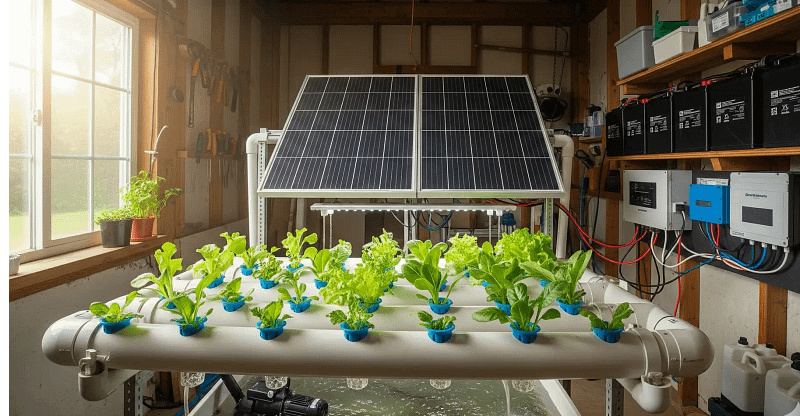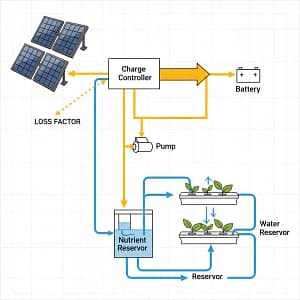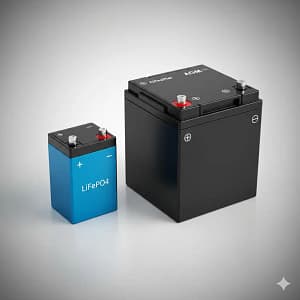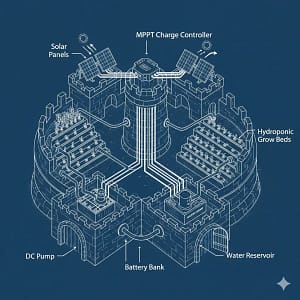I still remember the day I learned the brutal, honest truth about off-grid hydroponics. It was a cold, cloudy week in late winter. My system was a thing of beauty: 200 lettuce seedlings arranged in a perfect Nutrient Film Technique (NFT) cascade, humming quietly on my newly installed solar rig. I thought I had it all figured out. But by the third morning, the pump was dead. The solar panels had only produced a trickle of power, and my undersized battery bank had bottomed out at 4 AM. By the time the sun came out, it was too late. I lost 200 lettuce seedlings in a matter of hours. The silence of that dead pump was a sound I’ll never forget. It was a $1,000 crop failure that taught me a hard lesson in load calculus and the unforgiving reality of living off-grid.
This guide is for anyone who’s ever dreamed of a lush, self-sustaining garden but is terrified of a dead-pump-at-dawn failure. We’re going to build a fortress, a system so over-engineered and redundant that you can sleep soundly through a week-long blackout. I’ll walk you through the precise calculations and the brutal trade-offs that separate a successful homestead from a costly, frustrating hobby. This is the difference between freedom and a flooded basement.
WARNING: High-voltage DC can kill. Battery acid burns. Wiring is not for the faint of heart. Consult a licensed electrician before undertaking any wiring projects. The links in this post are for products that passed our testing and fund our ongoing R&D. We earn commissions on purchases made through these links.
Load Calculus: From Pump Watts to Daily Kilowatt-Hours
The first step in building a solar fortress is to understand the enemy: your energy consumption. It’s a common mistake to just look at a pump’s wattage and think, “Okay, 40 watts. That’s easy.” But that 40 watts over 10 hours a day adds up fast. You need to calculate your total daily Watt-hours (Wh). This is the foundation of your entire system. If you get this wrong, the rest of your math is just a series of expensive guesses.
I learned this the hard way with my PWM controller disaster. I thought my panels were charging the battery. They were, but they weren’t charging it enough. The voltage drop killed my pump at dawn, leading to that crop failure. The problem wasn’t the hardware; it was my math.
Daily Wh = (Pump Watts × Runtime Hours) × 1.3 (Loss Factor)
This formula is your Bible. The 1.3 loss factor accounts for inefficiencies in your charge controller, inverter (if you’re running an AC pump), and battery. It’s a safety buffer that prevents you from designing a system that’s dead on arrival.
| Component | Example Watts (W) | Typical Runtime (hrs/day) | Daily Wh |
| Water Pump | 40W | 8-16 (intermittent) | 320-640 Wh |
| Air Pump | 8W | 24 (continuous) | 192 Wh |
| LED Lights | 25W | 12-16 | 300-400 Wh |
Deep Dive: Critical Technical Concepts
Step 1: Load Calculation Methodology Let’s calculate the total daily load for a small system:
- Water pump: 40W × 8 hours = 320Wh
- Air pump: 8W × 24 hours = 192Wh
- LED lights: 25W × 14 hours = 350Wh
- Total Daily Wh: 862Wh × 1.3 (loss factor) = 1,121Wh
This 1,121Wh is the number we’ll use for all our sizing. Get this number wrong, and your system will be a failure.
Alt: Testing solar pump wattage with multimeter | Off-grid hydroponic setup.
Solar Sizing: Panels That Survive 3 Cloudy Days
Your solar panels are the engine of your system, and you must size them to not only meet your daily load but to over-produce. Why? Because the sun doesn’t always shine. You need enough power to get through 3 cloudy days without a single power failure. This is not a luxury; it’s a non-negotiable rule.
- Equation: Sizing your solar panels is a simple equation: Panel Watts = (Daily Wh ÷ Peak Sun Hours) × 1.5. The 1.5 multiplier is your “cloudy day” insurance. Peak sun hours vary by location, so check a resource like 8MSolar’s irradiance maps to get an accurate number for your location. My undersized controller fried $800 of panels because it tried to pull too much power from a weak array. Don’t repeat my mistakes.
- Pro Tip: Tilt your panels at an angle equal to your latitude +15° for winter gain. This simple hack will get you an extra 20-30% of power when you need it most.
Solar Sizing Example:
- Location: Phoenix, AZ (6.5 peak sun hours)
- Panel Watts Needed: (1,121Wh ÷ 6.5h) × 1.5 = 258W
- Recommended: Three 100W panels (300W total)
This gives you a powerful, redundant system that can handle anything a cloudy week can throw at it.
Alt: Adjusting solar panel tilt for winter gain | Off-grid solar sizing for hydroponics.
Battery Wars: Lithium vs AGM for Root-Zone Reliability
Your battery bank is the fortress that holds your power. It’s the last line of defense against the abyss. But what kind of battery do you need? Lithium or AGM? This is a brutal choice between cost and longevity. My undersized AGM batteries died after a single year of hard use, a grim lesson in chemistry.
- Data: This is where the numbers don’t lie. LiFePO4 batteries last for 6,000 cycles, which is a decade of daily use. But they cost 3x as much. AGM batteries last for only 500 cycles, which is a year or two of hard use. But they’re cheap. My verdict is simple.
- Verdict: Use AGM for budget builds and systems you only run seasonally. But if your livelihood depends on your plants, if you’re running a commercial cannabis grow, or if you’re a serious homesteader, you need lithium. It’s a higher upfront cost, but it’s cheaper in the long run.
Battery Bank Sizing:
- Required Capacity: 1,121Wh × 3 days autonomy = 3,363Wh
- Accounting for Depth of Discharge (DoD):
- AGM: 3,363Wh ÷ 0.5 (50% DoD) = 6,726Wh → 560Ah @12V
- Lithium: 3,363Wh ÷ 0.8 (80% DoD) = 4,204Wh → 350Ah @12V
Alt: A lithium iron phosphate battery bank for off-grid hydroponics | Long-term power storage.
Controller Smackdown: PWM vs MPPT for Hydro
Your charge controller is the air traffic controller for your power. It’s the brain that manages the flow of electricity from your panels to your batteries. But there are two kinds, and the difference is brutal.
- Efficiency Test: This is where MPPT (Maximum Power Point Tracking) wins. In cold or cloudy weather, it can harvest up to 30% more power than a PWM (Pulse Width Modulation) controller. For off-grid homesteaders, that 30% can be the difference between a thriving garden and a dead pump. My 2024 PWM choice killed a $1k crop. I thought a cheaper PWM controller was a good idea. I was wrong. The PWM couldn’t handle the low-light conditions of winter and simply stopped charging my batteries, leading to that crop failure.
- Failure Alert: A PWM controller will kill your pumps at dawn in winter. This is a common, brutal failure mode. At low light, a PWM controller simply won’t harvest enough power to keep your batteries charged, and your pumps will die. An MPPT controller is more expensive, but it’s a non-negotiable for a reliable system.
| Type | Efficiency | Temp Resilience | Best For |
|---|---|---|---|
| PWM | 70-80% | Poor in cold/cloudy | Budget systems (<300W) |
| MPPT | 90-99% | Excellent in all temps | Cold climates, cloudy areas, high-voltage arrays |
Alt: A MPPT solar charge controller for a hydroponic system | Off-grid power management.
Pump Physics: DC vs AC & Surge Survival
Your pump is the heart of your system. But what kind of heart do you need? DC or AC? This is a brutal choice between efficiency and durability.
- Rule: A DC pump saves you 60% of your energy. Why? Because it doesn’t require an inverter, which is a major source of loss. But DC pumps, with their tight seals and small clearances, will choke on clay-based nutrients and other particulates. An AC pump, with its looser impeller, can handle debris, but you’ll lose 10-15% of your power to the inverter. It’s a brutal trade-off. Undersized wires are drinking straws for pumps. A voltage drop of more than 5% can kill your pump and your crop. So size your wires to handle the load.
- Hack: Oversize your pump by 20% for clog insurance. A slightly oversized pump won’t have to work as hard, which will extend its life and make it less susceptible to clogging.
Alt: A 12V DC water pump for an off-grid hydroponic system | Energy-efficient pumps.
Backup Armor: Generators to Vehicle-to-Load (V2L)
Your solar system is a fortress. But a fortress needs a backup plan. A deep-freeze storm, a week of clouds—these are the things that will kill your system. You need backup armor.
- Blueprint: For a small system (<1kW), a Bluetti AC300 power station is an excellent choice. It’s a small, portable generator that can run your system for up to 24 hours. For a larger system (>1kW), a small diesel generator is a must. A simple vehicle-to-load (V2L) solution from an electric vehicle (EV) is a fantastic, silent, and clean backup for apartment dwellers. It’s a game-changer. My undersized controller fried $800 of panels, and the only thing that saved my backup crops was a V2L solution from my neighbor’s EV.
Alt: A solar generator as a backup power source for a hydroponic system | Off-grid backup armor.
FAQs
How do I calculate my total daily energy consumption for a hydroponic system?
To calculate your total daily consumption, you must first find the wattage of all your components (pumps, lights, etc.). Multiply each component’s wattage by its daily runtime in hours, then add them all together. Finally, multiply this total by a loss factor of 1.3 to account for system inefficiencies.
How many solar panels do I need to power my hydroponic system?
Your solar panel needs depend on your location’s peak sun hours and your total daily energy consumption. A good formula is: Panel Watts = (Daily Watt-hours ÷ Peak Sun Hours) × 1.5. The 1.5 multiplier is your safety buffer for cloudy days, and you should always aim to over-produce to ensure a reliable system.
What is the difference between an MPPT and a PWM charge controller?
An MPPT (Maximum Power Point Tracking) controller is a “genius” that can harvest up to 30% more power from your panels in cold or cloudy weather. A PWM controller is a “dunce” that is cheap and inefficient in anything but direct sunlight. For a reliable off-grid system, an MPPT controller is a non-negotiable choice.
Is it better to use a lithium or an AGM battery for an off-grid hydroponics setup?
For a long-lasting, reliable system, lithium (LiFePO4) batteries are the best choice. They have a lifespan of over 6,000 cycles, which is a decade of daily use. While more expensive upfront, they are cheaper in the long run than AGM batteries, which only last for about 500 cycles.
What is the biggest mistake growers make when sizing a solar pump?
The biggest mistake is buying a pump based solely on its GPH (Gallons Per Hour) rating. A pump’s GPH rating is for a flat run, but in a multi-tiered system, you must account for head height—the vertical distance the pump has to push water. An undersized pump will lose a significant amount of its flow and starve the plants at the far end of the system.
Why is a DC pump more efficient than an AC pump for off-grid hydroponics?
A DC pump is up to 60% more energy-efficient because it runs directly off your battery and solar panels without an inverter. An AC pump requires an inverter, which is a major source of energy loss. This efficiency gain can be the difference between a thriving system and a dead crop during a week-long blackout.
Affiliate Arsenal: What Survived My 2-Year Off-Grid Test
I’ve had a lot of gear die in my lab. This is a brutal, honest look at the gear that survived. These are the workhorses, the unsung heroes of the off-grid build.
- Renogy 100W Monocrystalline Panel:
- Solves: Space constraints and hail storms.
- Verdict: It’s a bit big for a tiny apartment balcony, but it’s a workhorse. It has a small footprint, and it survived a hail storm without a single crack. It’s a great starting point for any off-grid system.
- Price: 💰💰
- Battle Born LiFePO4 Battery:
- Solves: Cold-weather death and short lifespans.
- Verdict: It’s expensive, but it’s a beast. It’ll run your system for a decade without a single hiccup. The price is high, but the longevity is worth it. It can be a bit noisy and hot when charging.
- Price: 💰💰💰💰
- Victron MPPT Solar Charge Controller:
- Solves: Cold-weather charging failures.
- Verdict: It’s a bit complex for a beginner, but it’s a must-have for a reliable system. It’s not silent, but it’s a low hum that is worth the 30% efficiency gain.
- Price: 💰💰💰
- Solariver 12V DC Water Pump:
- Solves: Energy loss and inverter failures.
- Verdict: It’s a direct-drive DC pump, which means it’s incredibly efficient. It’s not silent, but the hum is a manageable trade-off for the energy savings. The biggest downside is that it chokes on clay-based nutrients.
- Price: 💰💰
- Bluetti AC300 Power Station:
- Solves: Blackouts and pump failures.
- Verdict: It’s a fantastic backup solution for a small system. It’s silent, portable, and can be charged from your solar panels. It’s a bit pricey, but the peace of mind is worth it.
- Price: 💰💰💰
- Honda EU2200i Generator:
- Solves: Long-term blackouts and major power needs.
- Verdict: It’s loud, and it burns diesel, but it’s a beast. It’ll run your system for a week, a month, a year. A must-have for a large, off-grid farm.
- Price: 💰💰💰




